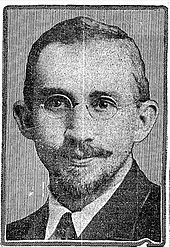Falaba (ship)
|
The Falaba at the moment of the torpedo hit, the bow of SM U 28 in the left foreground
|
||||||||||||||||||||||
|
||||||||||||||||||||||
|
||||||||||||||||||||||
|
||||||||||||||||||||||
|
||||||||||||||||||||||
|
||||||||||||||||||||||
The Falaba was a 1906 passenger ship of the British shipping company Elder Dempster & Company , which was used for passenger and cargo traffic from Great Britain to the British colonies in British West Africa . On March 28, 1915, the ship was sunk in the St. Georg Canal by a German submarine, with 104 people killed. The Falaba was one of the first British merchant ships sunk in World War I and the first to kill a US citizen.
The ship
The passenger and cargo steamer Falaba was built at the Scottish shipyard Alexander Stephen and Sons on the River Clyde in Glasgow . It was launched on August 22, 1906 and was completed in October of the same year. The triple expansion steam engines, which ran on two propellers , developed 424 hp and helped the ship to a cruising speed of up to 14 knots. The ship had a chimney, two masts and was 115.8 meters long, 14.3 meters wide and had a draft of 6.9 meters. A total of 190 passengers could be carried.
The Falaba operated on the Liverpool – West Africa route , calling at various ports such as Lagos ( Nigeria ), Sassandra ( Ivory Coast ) and Las Palmas ( Gran Canaria ) on this route . The passenger steamer was named after the city of the same name in West Africa. In the 19th century, Falaba was the capital of Solimana , a small West African state that was later incorporated into the British Empire and is now part of Sierra Leone .
Sinking
On Saturday, March 27, 1915 at 6 p.m., the Falaba left Liverpool under the command of Captain Frederick John Davis for another crossing. The goal was Freetown in Sierra Leone. On board were 95 crew members, 147 passengers (including 7 women) and a cargo worth around 50,000 British pounds .
At 11.40 a.m. on the morning of March 28, the steamer was sighted by the German submarine U 28 about 38 miles from the Smalls Lighthouse on the coast of the Welsh county of Pembrokeshire . The submarine was under the command of Kapitänleutnant Georg Günther Freiherr von Forstner . Von Forstner had sunk the 2,114 GRT passenger steamer Aguila of the Yeoward Line in the same area the day before , which had cost eight people their lives. The Falaba had hoisted the White Ensign , the British naval war flag.
U 28 adhered to the “Cruiser Rules” and gave the passenger steamer time to stop and allow passengers and crew members to disembark. The Falaba ignored the instruction and instead picked up top speed. Von Forstner gave a second signal: "Stop or you will be torpedoed". Captain Davis was aware that U 28 could make 16 knots and therefore decided to stop his ship. In addition, he let the lifeboats swing out and began to lower immediately. Although the ocean liner had given in and followed the instructions of the submarine, 23 minutes after the first contact , U 28 fired a torpedo at the unarmed ship, which sank only ten minutes later. In the short period of time only a few boats could be lowered safely. One of the boats was blown up by the torpedo explosion, while another capsized in the water.
Of the 242 people on board, 104 were killed (57 passengers and 47 crew members), including Captain Davis, the ship's doctor SV Daly and the stewardess Louisa Tearle. The survivors were recovered from the fishing trawlers Emma Eileen and Wenlock .
Among the dead was the 31-year-old mining engineer Leon Chester Thrasher (born September 19, 1883) from Massachusetts . He was the first American to be killed in German submarine attacks on British merchant ships. His death triggered violent reactions on the American side and was widely reflected in media reports and diplomatic notes. His body was not found until May 1915, when the Lusitania victims were recovered on the coast of southern Ireland .

